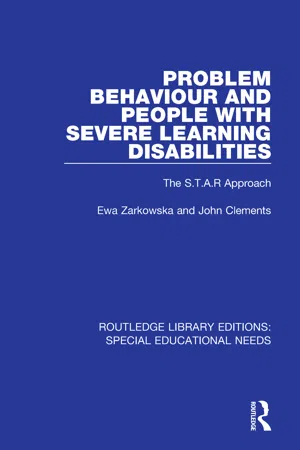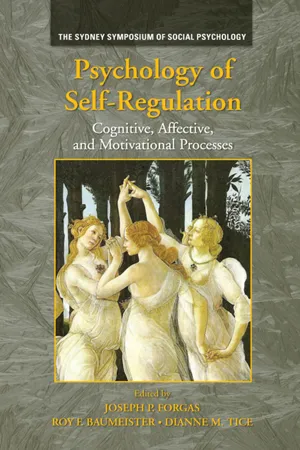Psychology
Self-Management Psychology
Self-management psychology refers to the practice of individuals taking control of their own behavior, thoughts, and emotions to achieve personal goals and well-being. It involves strategies such as self-monitoring, goal setting, and self-reinforcement to modify behavior and improve psychological functioning. This approach emphasizes the individual's active role in shaping their own experiences and outcomes.
Written by Perlego with AI-assistance
Related key terms
Related key terms
1 of 4
Related key terms
1 of 3
7 Key excerpts on "Self-Management Psychology"
- eBook - ePub
The Social Emotional Classroom
A New Way to Nurture Students and Understand the Brain
- Anna-Lisa Mackey, Melissa Ragan(Authors)
- 2022(Publication Date)
- Jossey-Bass(Publisher)
CHAPTER 3 Self-ManagementWhat Is Self-Management?
Like most people, you probably think self-management is synonymous with self-control. And based on the responses of other educators, you wouldn't be alone in your thinking:“Self-management is having the self-control to make good decisions for oneself.”- Occupational Therapist, ages Birth–15“The ability to control one's behavior and emotions appropriately for different settings.”- K–8 ELL Specialist“Managing your feelings alone and around others.”- High School Principal“In a word: Resilience. People that are able to bounce back from adversity are able to meet goals.”- K–12 Teacher Leadership“Being able to react appropriately in a given moment.”- Elementary Teacher“The ability to regulate one's emotional and physical state.”- High School TeacherAs with self-awareness, although these responses aren't wrong, self-management is about so much more than just self-control. CASEL identifies self-management as the ability to “manage one's emotions, thoughts, and behaviors effectively in different situations and to achieve goals and aspirations.”Some questions one might ask when trying to build self-management are:- What strategies do you use to manage your emotions?
- What stress management strategies are most effective for you?
- How do you model self-discipline?
- How do you demonstrate self-motivation?
- How do you set and achieve goals?
- What planning and organizational skills are most helpful?
- Are you able to take initiative and ask for help?
- What causes or inspires you to act?
What Does Current Research Say?
If the research on self-awareness seemed challenging, the good news is that the constructionist view of self-management seems much more straightforward. You might remember that the body is sending information to the brain all the time (interoception) and based on that information, the situation/context and your concepts, the brain makes predictions. Sometimes the predictions are instances of emotions. - Debbie Kralik, Barbara Paterson, Vivien Coates(Authors)
- 2016(Publication Date)
- Wiley-Blackwell(Publisher)
chronic condition self-management (‘self-management’) has emerged as a concept to describe the tasks, roles and responsibilities of individuals as they cope with their chronic conditions from diagnosis to their long-term management. This chapter will provide international, historical and policy contexts to self-management – describing associated concepts that overlap with or inform an understanding of self-management from both the person’s and the health professional’s perspective. It will also describe the development of self-management concepts and practical applications of these, including nationally accepted definitions of self-management in Australia.Background to the use of the term self-management
The individual’s perspective
There is little explicit recognition that being diagnosed with a chronic illness is a critical life event for the individual. Such a crisis has well-defined characteristics (Caplan 1964; Gunderson & Rahe 1974). Put simply, it is a time of emotional disequilibrium and one that needs resolution through the learning of new skills to cope with the challenge that is presented. Once the challenge is confronted, dealt with and overcome, the person achieves a sense of mastery, and self-efficacy grows (Bandura 1977). This is the first step in developing an effective self-management approach to any clinical condition.The person’s experience of chronic illness is subjective, interpersonal and social. Self-management tasks involve an understanding of and distinguishing between the illness experiences, levels of distress, perceived loss of well-being, illness behaviour and the impaired functioning observed by others. Optimal self-management has the potential to also reduce the effects of the conditions or diseases on the person, such as social stigma and exclusion, and increase levels of participation in the family and community. Self-management tasks promote full personal and social well-being. Likewise, the carer’s perspective is unique. It involves the impact that caring for someone with chronic illness has on the carer’s role, interpersonal relationships with the person and others as well as their own careers and lives (Australian Bureau of Statistics 2003).- eBook - ePub
Leadership Development
Paths To Self-insight and Professional Growth
- Manuel London(Author)
- 2001(Publication Date)
- Psychology Press(Publisher)
3 Self-Regulation: Processes for Maintaining Motivation and Resilience
DOI: 10.4324/9781410604514-3One important facet of gaining self-insight is being able to incorporate new information about themselves and make changes in their behavior and performance. Leaders need to be able to regulate their behavior effectively and respond appropriately in different situations and under different conditions. They need to understand their capabilities in relation to the changing demands of the business. As they get feedback about what is and is not working, they may need to alter their views of themselves. This requires recognizing that the information disconfirms what they already thought about themselves (an uncomfortable position to be in) and then using the information to revise their self-concept and change their behavior. This is the process of self-regulation. Self-regulation allows people to maintain their motivation and have the resilience they need to overcome barriers to goal accomplishment.This chapter examines how leaders and people, in general, regulate their behavior. The chapter considers conditions that foster self-regulation and what happens when leaders fail to regulate their actions and change their self-concepts. The discussion begins with a general explanation of self-regulation.The Meaning and Value of Self-Regulation
Self-regulation, or self-control, is any effort to alter one’s own responses, whether these responses are thoughts, actions, feelings, desires, or performances (Baumeister, Heatherton, & Tice, 1994 ). Without self-regulation, peopie would respond to a situation on the basis of merely habit, inclination, or innate tendencies. Self-regulation prevents this natural response and substitutes another, or there may be a lack of response altogether.Self-regulation involves a hierarchy of processes. Lower processes are immediate reactions that are generally gratifying. Higher order processes entail longer time spans, such as postponing or foregoing gratification. When giving in to instant or rapid gratification overrides a resolution to abstain, the individual has failed in self-regulation. This implies a competition between responses. Higher processes suggest standards individuals would like to attain. However, this requires the strength to overcome natural tendencies and achieve a higher order response, which may be equally or more rewarding, but the rewards may be longer in coming. Not succumbing to natural or habitual tendencies requires strength (or willpower). It also requires a supportive environment. Few people can resist a rich chocolate cake if it is shoved in front of them for desert or is readily available every time they open the refrigerator door. However, if the environment limits temptation and provides support for control (the Weight Watcher’s concept), then people are more able to resist. - eBook - ePub
Problem Behaviour and People with Severe Learning Disabilities
The S.T.A.R Approach
- Ewa Zarkowska, John Clements(Authors)
- 2018(Publication Date)
- Routledge(Publisher)
For the person with learning difficulties who is the recipient of external control programmes there are other difficulties. It may lead the individual to view himself as incapable of independent action, thus increasing his sense of dependency and blocking this area of personal development. It may create frustration if he has developed personal decision-making skills but is not given the opportunity to use them. Frustration may contribute to the further creation of behaviour deemed to be inappropriate. Finally, it may influence how others view him, seeing him as by nature unable to take responsibility for his own actions.There are, therefore, many good reasons for involving people with learning difficulties in the management of their own behaviour, for helping them to take greater responsibility for their actions and for reducing reliance upon external methods of behavioural change and control - in other words, for teaching and encouraging self-management.Figure 9.1 Encouraging self-management.Self-Management - General Principles
Defining Self-Management
Self-management describes the situation where some of the key factors which influence how an individual behaves come from within the person or are in some other way under the direct control of the individual. The word ‘some’ is a reminder that self-and external control are not contradictory ideas. The influences over human behaviour in any situation are many and varied and may include factors over which the individual has direct control and those over which he has no control. The precise balance of external and internal control factors will depend upon both the situation and the level of development that the individual has reached. In general terms, two broad categories of self-management can be identified - self-direction of behaviour and independent problem solving.Self-direction of behaviour
Self-direction of behaviour occurs when the individual implements specific procedures to ensure that certain specific behaviour occurs. He can structure settings (for example, arrange a time and place for studying which is likely to be distraction-free). He can manipulate cues which increase or decrease the likelihood of performing certain actions (for example, write out a time-table for what is to be studied). He can provide direct triggers for the starting and stopping of his behaviour (for example, set an alarm clock to signal the start of a study period, then reset it to signal the end of the study period). He can provide reinforcing results for desirable actions (for example, a refreshment break following completion of a time-tabled piece of study). He can monitor and evaluate his progress (for example, chart the proportion of study assignments completed in relation to the number planned). In this way the individual takes active steps to ensure that certain of his own behaviour occurs. - eBook - ePub
Psychology of Self-Regulation
Cognitive, Affective, and Motivational Processes
- Joseph P. Forgas, Roy F. Baumeister, Dianne M. Tice, Joseph P. Forgas, Roy F. Baumeister, Dianne M. Tice(Authors)
- 2011(Publication Date)
- Psychology Press(Publisher)
1 The Psychology of Self-Regulation An Introductory Review Joseph P. Forgas University of New South Wales Roy F. Baumeister and Dianne M. Tice Florida State UniversityDOI: 10.4324/9780203837962-1Contents
- Early Approaches to Self-Regulation: From Adam and Eve Onward…
- Self-Regulation and Social Life
- Self-Regulation in Psychology
- Domains of Self-Regulation
- Self-Regulation: Conscious or Unconscious?
- Goal-Oriented Behavior and Self-Regulation
- Individual Differences in Self-Regulation
- Types of Self-Regulation
- Ingredients of Self-Regulation
- Overview of the Book
- Part 1: Motivational Processes in Self-Regulation
- Part 2: Self-Regulation and Goal-Oriented Behavior
- Part 3: Affective and Cognitive Processes in Self-Regulation
- Part 4: Self-Regulation and Social and Interpersonal Processes
- Conclusions
- Author Note
- References
The ability to control and regulate our actions is perhaps the quintessential characteristic of human beings. Indeed, the capacity to engage in effective self-regulation is probably one of the defining features of our species. Homo sapiens could just as well be called homo temperans (from the Latin, “the self-controlled man”), as our ability to regulate and control our actions represents a key evolutionary achievement. While some primates certainly display some elements of social thinking (Dunbar, 2007 ), no other species comes even close to us in its ability to engage in effective self-regulation and self-control in order to achieve distal goals. It may be argued that any systematic thinking and the use of conscious will (and there may not be all that much of it; see Wegner, 2002 ) largely serves the evolutionary functions of long-term self-regulation and self-control (Forgas, Haselton, & von Hippel, 2007 ; see also Oettingen & Gollwitzer, Chapter 8 , this volume; Carver & Scheier, Chapter 7 - eBook - ePub
- Jonathon Brown(Author)
- 2014(Publication Date)
- Psychology Press(Publisher)
The third section of this chapter will focus on behavior in achievement situations. Here we will examine how self-relevant thoughts and feelings influence persistence and performance in classroom settings.Finally, we will consider situations in which people fail to effectively regulate their actions. Our concern here will be with understanding how people’s self-relevant thoughts and feelings can contribute to negative behaviors, such as alcoholism, aggression, and suicide.A GENERAL MODEL OF SELF-REGULATION
Three Component Processes
Self-regulation models are concerned with what individuals choose to do and how they go about trying to accomplish their goals. In more formal terms, we can distinguish three components of the self-regulation process: (1) goal selection, (2) preparation for action, and (3) a cybernetic cycle of behavior (made up of several component processes) (Markus & Wurf, 1987).Goal Selection
The first stage in the self-regulation process is the goal-selection stage. Before they can effectively regulate their behavior, people must select a goal; they must decide what they intend to do.Many motivational theorists assume that goals arise in the context of an expectancy-value framework (Atkinson, 1964; Rotter, 1954). Expectancy-value models assume that people select goals according to their expectancy of reaching the goal, in conjunction with the positive value they place on attaining the goal and the negative value they place on not attaining the goal. The idea here is really quite simple. If, for example, we want to predict whether a person will adopt getting a Ph.D. in psychology as a goal, we would want to know how likely the person thought it was that she would successfully complete the Ph.D. requirements and the value she places on receiving versus not receiving a Ph.D.In an expectancy-value model, these factors are assumed to combine in a multiplicative fashion. This means that we multiply (rather than add) the two factors together to determine the strength of an individual’s motivation to engage in some behavior. This assumption has an interesting and important consequence. It means that if either value is set at zero, the goal will not be adopted. If a person sees no possibility that she can successfully complete a Ph.D. program (i.e., if expectancy = 0), she will not apply to graduate school, no matter how much she might value getting a degree. Conversely, if she places absolutely no value on getting the degree (i.e., if value = 0), she will not apply to graduate school no matter how probable she thinks success would be. - eBook - ePub
Self-Regulated Learning and Academic Achievement
Theoretical Perspectives
- Barry J. Zimmerman, Dale H. Schunk, Barry J. Zimmerman, Dale H. Schunk(Authors)
- 2013(Publication Date)
- Routledge(Publisher)
planning and strategy selection, students have the opportunity to put themselves in action, to make personal plans, and to select the appropriate strategies for accomplishing learning goals expressive of their more general self-development and self-determination goals. In specific learning situations, the personally meaningful and relevant goals students selected for mastery, accomplishment, or growth in knowledge and skills have the purpose of forming and directing the kind and nature of planning activities and strategies selected. At this step, it is critical that students have developed the level of metacognitive knowledge (including self-knowledge) and processes (including self-monitoring, self-reflection, and self-evaluation) for engaging in effective planning and strategy selection.The final step of self-regulation, performance execution and evaluation, further requires the development of self-monitoring, self-reflection, and self-evaluation processes. To put the self in action, students need to direct and maintain their attention appropriately, evaluate their progress relative to desired goals, regulate and control their affect, and execute the actions necessary for reducing the performance discrepancies between actual and desired goals. Again, the development of self-awareness, self-monitoring, and self-evaluation processes is critical to effective performance execution and evaluation in a self-directed and self-regulated sense. For students lacking in self-knowledge and self-regulation processes, interventions help to enhance or supplant existing self-values, capacities, and skills.Practices That Enhance Self-Regulated Learning by Focusing on Understanding of Inherent Capacities for Motivation and Learning
Another approach to the development of self-regulated behavior is that developed by Mills (1995). This approach suggested that self-regulation is the natural response to learners’ understanding of their inherent capacities for motivation and learning—combined with their understanding of the role of their thinking in feelings and motivation as well as their agency in choosing what to think on a moment-to-moment basis. From this perspective, the interventions most needed are those that educate
Index pages curate the most relevant extracts from our library of academic textbooks. They’ve been created using an in-house natural language model (NLM), each adding context and meaning to key research topics.
Explore more topic indexes
Explore more topic indexes
1 of 6
Explore more topic indexes
1 of 4






